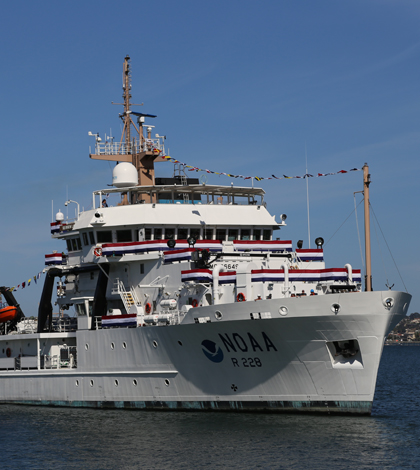NOAA Ship Reuben Lasker commissioned for oceanographic surveys

NOAA Ship Reuben Lasker pulls into the Navy Pier in San Diego in advance of her May 2 commissioning (Credit: David Hall/NOAA)
The National Oceanic and Atmospheric Administration commissioned a new, cutting-edge research vessel early this May. The NOAA Ship Reuben Lasker features a number of technological advancements to help the scientists onboard better study fish and other marine animals.
“Our old research vessel, the David Starr Jordan, was retired in 2009, so we’ve been without a vessel since that time,” said Roger Hewitt, assistant director at NOAA’s Southwest Fisheries Science Center. “It’s great to have a vessel back in service.”
Named after the late fisheries biologist Reuben Lasker, the 208-foot ship is outfitted with “a full suite of modern instrumentation for fisheries and oceanographic research,” according to a NOAA press release. This includes sampling gear, sensors and fully-equipped laboratories for the ship’s detachment of 15 scientists.
“We have a large suite of acoustic instrumentation that is both down-looking and side-looking, and an extensive array of devices to do direct sampling,” Hewitt said.
The Reuben Lasker won’t conduct its first survey until late July, but Hewitt drew on past experiences to outline what a typical day of research might look like.
“One of the surveys we do is the California Cooperative Oceanic Fisheries Investigations,” Hewitt said. Known in short as CalCOFI (pronounced cal-coffee), the survey has been conducted in partnership with the Scripps Institution of Oceanography in San Diego, California since the 1940s.

The Reuben Lasker underway. (Credit: Ted Bradley/NOAA)
Like so many studies, CalCOFI began with a question: Where did all the California Pacific sardines go? While the sardines eventually experienced a revival in the 80s and 90s, current environmental conditions are causing another decline in population. However, Hewitt said the oceanic conditions favorable for the species’ spawning and reproductions could not have been identified without CalCOFI and the use of NOAA research vessels.
“If we didn’t have the survey, we wouldn’t be able to piece all of the puzzle together,” Hewitt said. “In order to do a CalCOFI survey, we are sampling not only the reproductive ability of the fish, but also aspects of the environment.”
The Reuben Lasker will acquire samples much like its predecessors: by establishing and gathering data from a series of oceanographic stations.
During a survey, the Reuben Lasker will transit between stations, casting plankton nets at each one. CTD sensors — measuring conductivity, temperature and depth — are deployed alongside other sensors, producing vertical profiles for a variety of oceanographic characteristics such as salinity, fluorescence and nutrient load.
Those types of surveys are round-the-clock affairs, Hewitt said. But the Reuben Lasker truly shines during surveys of marine life, where its technological advancements set it far above earlier research vessels.
“One of the big characteristics of the new ship is that it’s very acoustically quiet,” Hewitt said. “This allows us to reduce the reaction of animals that we’re surveying to the presence of the ship, thus reducing the bias.
“More importantly, it enhances the signal-to-noise ratio of our acoustic instrumentation,” he said.
Unique hull design facilitates the ship’s low acoustic output, cutting bubble washdown and turbulence as it glides through the water. Furthermore, the prop is specially designed to minimize cavitation and all engines are shock-mounted to absorb vibrations. All of the ships individual compartments are insulated as well.
“When you’re on the ship, you don’t even know you’re moving… unless you look out the window,” Hewitt said.
When conducting marine mammal surveys, the Reuben Lasker’s scientists keep their eyes and — instrumentally enhanced — ears open.
“Our primary mode of observation is visual, and we also tow a hydrophone array behind the ship,” Hewitt said. “We put a workboat over the side when we spot a group of whales, and take tissue samples from which we can run genetics and hormone analysis.”
The Reuben Lasker’s maiden survey will examine marine mammals on the West Coast. Lasting 120 days, the survey will take the ship and its crew from Baja California to British Columbia.
The Southwest Fisheries Science Center conducts biological, oceanographic and economic research on resources across the Pacific Ocean and in Antarctica’s Southern Ocean. Though the Reuben Lasker is not outfitted for voyages through the icy Southern Ocean, early shakedown cruises have proven its capabilities along the U.S. West Coast and Pacific regions.
“The ship is performing very well,” Hewitt said. “We’re very pleased with it.”
Top image: NOAA Ship Reuben Lasker pulls into the Navy Pier in San Diego in advance of her May 2 commissioning (Credit: David Hall/NOAA)





0 comments